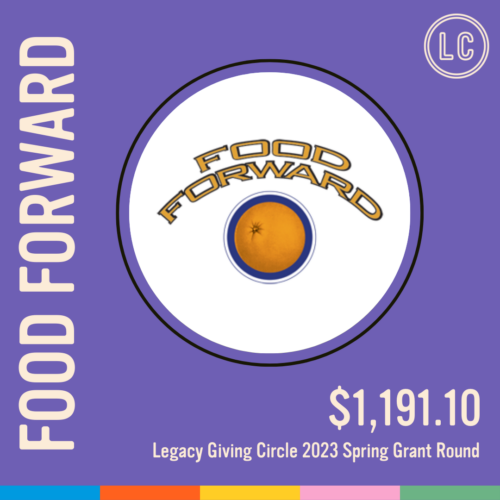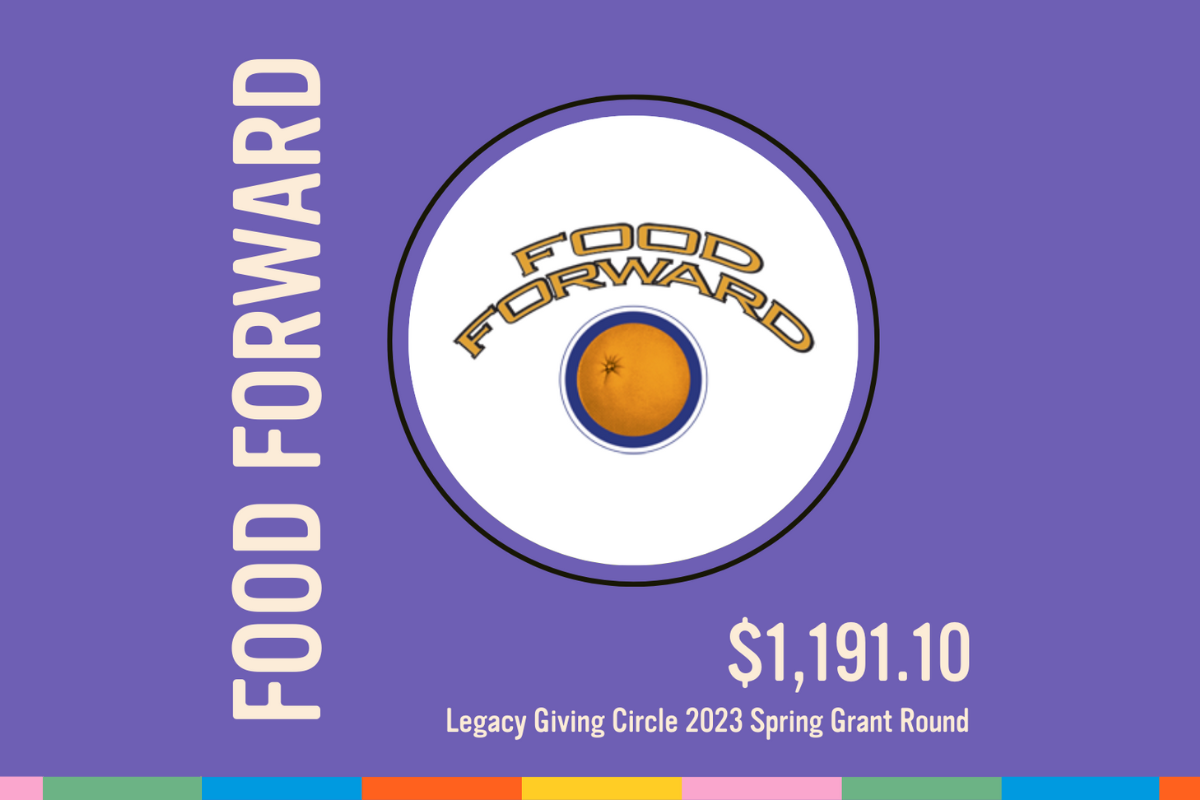
We are excited to announce our 9th 2023 Spring Grant Recipient!
Thanks to our generous Legacy Giving Circle donor community, Food Forward is receiving a $1,191.10 grant towards increasing community produce recovery.
Initiative Location: Los Angeles, California
Initiative Cause Areas: Environmental; Farming and Agriculture; Food Insecurity
UN Sustainable Development Goals: 02 Zero Hunger; 13 Climate Action
Initiative Description: Food Forward is an innovative, community-driven food recovery organization that rescues exclusively fruits and vegetables from backyard fruit trees, orchards, farmers markets, wholesale produce distributors, and growers, then distributes this fresh produce to hundreds of hunger relief partner organizations that distribute it free of charge to people experiencing food insecurity.
Through volunteer-based Community Programs, Food Forward organizes thousands of dedicated volunteers annually to participate in picks and gleans: Food Forward’s Farmers Market Recovery program is a market endorsed donation system for farmers wanting to help fight hunger with their unsold produce; it currently operates at 14 markets and benefits dozens of partner organizations annually. Our flagship Backyard Harvest program provides fruit to partner organizations from volunteer-driven picks on hundreds of fruit tree properties annually. The volunteer-based Community Programs increase efficiency and maximize the sustainability of our food recovery operations while educating community volunteers about food insecurity, inspiring social consciousness, and promoting community leadership in our mission for change. Through Food Forward’s Wholesale Recovery Program, staff collects surplus produce donated by the pallet- and truckload from wholesale produce distributors and growers. We then create large loads of mixed pallets of fruits and vegetables for distribution free of charge to hunger relief partner organizations. Since its founding in 2009, Food Forward has recovered and distributed more than 300 million pounds (nearly 1.7 billion servings) of fresh fruits and vegetables to partner organizations. By preventing this food from becoming waste, Food Forward has also prevented the emissions of more than 267,000 metric tons of CO2 equivalent. Food Forward’s produce rescue programs serve nine counties in California, with the primary Community Program recovery and distribution locations in Los Angeles and Ventura counties. Occasionally, produce is delivered to adjacent states and tribal lands, including Arizona, New Mexico, Nevada, and Texas.
While the Wholesale Recovery Program has been the primary driver of impact in terms of pounds of fresh food distributed, the Community Programs have steadily rescued and distributed an average of one million pounds of produce through more than 1,500 volunteer-led harvests of fruit trees and gleans at local farmers markets each year – as well as inspiring volunteers and the donors of fruits and vegetables to be part of a simple solution to address food insecurity. Essential to a new phase of growth for Food Forward’s efforts to engage communities, Legacy Giving Collective support will help to build the capacity of the Community Programs to develop relationships with new produce donors and partner organizations; increase outreach to and engagement of the community as volunteers; and strengthen infrastructure to manage increasing data and program size. As a result, we can increase the sources of fresh fruits and vegetables and increase the volume of healthy food distributed in the future.
To increase the amount of food we can provide to communities, in 2023, we will:
- Identify locations for and begin Backyard Harvest volunteer picks at three additional high-volume fruit tree properties (especially for citrus season).
- Assess three additional farmers markets for regular staff- and volunteer-led gleans of surplus produce, then confirm arrangements with market management and begin recruiting volunteer leads to implement new gleans.
- Recruit and train at least 50 additional volunteer leaders to lead increasing numbers of community harvests and gleans, enabling Food Forward to provide consistent access to fresh food for more than 130 hunger relief partners through the Community Programs. These volunteer leaders not only recover produce more quickly and in smaller groups than general volunteers but also increase capacity for Food Forward’s Community Programs staff – as specially-trained supporters, they can coordinate supplies and help to oversee volume, produce type, and receiving hunger relief program records for each pick and glean.
- Pilot up to two volunteer opportunities for people for whom English is a second language and for people with differing abilities that will provide lessons to expand programming.
- Launch the Community Ambassador program through which volunteers will attend community events to educate the community about food recovery and food waste.
- Recover and distribute a total of 920,000 pounds of fresh fruits and vegetables through more than 1,690 staff and volunteer-powered “events” – fruit picks on more than 600 properties and gleans at up to 17 farmers markets.
A $25,000 grant from the Legacy Giving Collective will fund essential Community Programs expenses, as detailed below:
- $15,000 to partially fund salary and related for the Senior Manager of Community Programs position. As the Community Programs increase capacity in 2023, this new position, hired in late 2022, will work closely with the Director of Community Programs in the strategic growth of the program, including oversight of the growing number of program staff, equipment, and vehicles; and management of new relationships with fruit tree donors, farmers market managers, and partner organizations.
• $10,000 to support vehicle fuel, maintenance, insurance, and registration – our highest expense after staff. Increased output and diversified produce sources require additional resources to travel to additional farmers markets and fruit tree properties to implement programs and stock supplies.
Initiative Impact: Food Forward’s primary measures of impact include the number of pounds of fresh fruits and vegetables recovered and distributed (projected: 80 million organization-wide in 2023), and the number of partner organizations served by that food (projected: more than 300 in 2023). Secondarily, annually Food Forward calculates the metric tons of CO2-equivalent prevented by our food recovery (projected: 71,200 metric tons in 2023), the social impact value of that donated produce (projected: more than $150 million value for fresh produce donated to our hunger relief partners in 2023), the number of volunteer-led harvests (projected: 1,690 in 2023), and efficiency in the operational cost to recover and distribute one pound of produce (estimated at $0.07 per pound in 2022 and projected to be similar in 2023).
The intended outcomes of Food Forward’s Community Programs growth are improved access to fresh fruits and vegetables and health equity in the low-income communities our hunger relief partners serve. Hunger relief services offered by our partner organizations vary from hot, prepared meals, to food pantry models, to large-scale food bank programs, to deliveries of grocery boxes, and everything in between. The population served is diverse and includes people of all ages and backgrounds. Food insecurity typically affects unhoused individuals, seniors, college/community college students, veterans, LGBTQ+ individuals, single-parent households, and Black- and Latine-headed households at higher rates. The produce we provide consistently to our hunger relief partners helps address their clients’ food security and access to fresh food, which contributes to disease prevention. For many of our partner organizations, having a steady source of donated produce allows them to focus resources on meeting other needs of their clients, such as housing, job search, child care, health care, and more. Another outcome: By preventing this surplus food from going to waste, Food Forward prevents emissions that contribute to climate chang and have an outsized effect on low-income and vulnerable populations.
At the same time, the fruit tree donors who register their properties for volunteer picks, the vendors at farmers markets who donate their surplus at the end of the market day, and the thousands of volunteers who harvest and glean are all educated about food recovery as a solution to increasing rates of food insecurity in our region, as well as the climate benefits of reducing the amount of fresh food added to landfills.
Initiative Sustainability: After expanding its program in 2020 in response to the pandemic, Food Forward has consistently rescued and distributed more than 60 million pounds of surplus fruits and vegetables in each of the last three years – a 130% increase over 2019. Food Forward has now proven the power of its produce recovery model and strong hunger relief network to nimbly recover high volumes of surplus produce from the region’s growers and wholesalers, and distribute that abundance free of charge to people who lack access to healthy food. Programmatically, Food Forward is refining workflows, upgrading systems, and adding staff for food recovery, distribution, and partner organization relations (“agency relations”). Internally, we are investing in technical capacity, and administrative, financial, and human resources staff to support the growth in output.
Food Forward’s sustainable income profile includes long-term relationships with foundation supporters, a growing individual giving program, corporate grants and partnerships, fundraisers and special events, and government grants in support of food waste prevention. In recent years, Food Forward has attracted new support from a growing base of institutional and individual supporters, and the Board of Directors has committed to investing in strong fundraising and finance teams. In 2020, Food Forward received a generous gift that enabled the organization to open a formal, Board-designated reserve fund for the first time and continues to hold six months of operational costs in reserve in case of emergency. Forward has successfully ended with a net positive financial position in each of our 14 years of operation, through both strong cost management and fundraising efforts. We are confident that this will be maintained over the long term.
